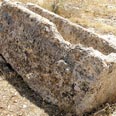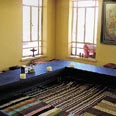


It is hot now in the Jordan Valley, but the sweat dries in the wind. The far reaching scenery is a sight to see. The silence, that seems to have existed since creation, is good for the soul. The tourist can expect quite a few watery surprises on the way.
The inhabitants of the Valley are essentially different types of mammals. Here for instance, one can see large flocks of deer. During a two to three hour walk one can see over thirty deer. The porcupine is also widespread in the area, and the hyrax hides in the rocky sections. In the vegetation on the banks of the Jordan one can find wild pigs, desert cats, jackals and polecats.
“Brosh HaBika”, less than a ten minute drive south of Mechola junction, will help plan individual tours for hikers. But if one does not know the area well it is advised to take a guided tour. In certain areas, along the border with Jordan for example, security clearance is needed. An individual hiker will have a hard time obtaining clearance.
There are the Gilad Mountains
From “Brosh HaBika” one can take a jeep trip (middle to hard difficulty level) that crosses different areas. Travel several dozen meters south on route 90 and turn immediately onto a run down asphalt road (Maaleh Shai) that leads to an army base at the top of the ridge. On the way, stop to overlook Mount Gilad on the East and the Shomron mountains on the west. At the bottom of the Gilad lies the large village of Kureima.
From another observation point along the way one can see the Jabbok River that separates Mount Gilad in the north from Mount Moab in the south, with Emek Sukkot in between. The Jabbok River, according to the Biblical story, is where Jacob fought with the angel of God, a struggle that gave birth to the name Israel (“For you have striven with God”).
Cross several wadis and reach Khirbat Sueeda, where there was a Roman-Byzantine city during the fourth and sixth century. After the Arab conquest in the seventh century, it was destroyed. Remains of the city can be clearly seen at the site, including a concentration of stone graves strewn through the area and a burial quarry.
Return to the main road and turn at the junction toward Um Zuka. The panoramic view reveals the Shomron Mountains to the west and the imposing Mount Sartaba in the south. At Um Zuka there are several large wells of water and it is just a matter of time until a shepherd comes to water his flock. From Um Zukkah proceed to route 578 and from there go north to Mechola junction and return to the “Brosh”.
Stop! Border ahead
Here is another trip (high level difficulty)
Travel north from Tzomet Adam on Route 90 and turn west at the sign in the direction of Ras Al Kharuba. The ascent is on a run down asphalt road. On the left one can see the archeological remains of an Israeli fortress from 800 B.C.E., called Hurbat Mahruk (the Burnt Ruin).
A dirt path leads to an observation point from where one can see Moshav Argaman from one side and Nachal Tirtzah on the other side. The road that crosses Nachal Tirtzah is called Jiftlik, “Sultan’s Lands” in Turkish. Today the land is owned by wealthy people from Nablus and local tenants work the land.
Return to Route 90, towards the eastern crossing of the security road. It is worth bothering the security forces in order to tour the Tirtzah reservoir. The site can only be entered by groups of at least three cars- obviously by advance notice (Tour Coordinator Central Division 972-2-5305511).
At the site there are three graded dams situated on Nachal Tirtzah, east of the Bekaa Road, before the river flows into the Jordan. The upper part of the reservoir is used to absorb mud and silt, the middle part for rain collection, and the lower part a winter pool just for tourists.
An artificial reservoir situated on a nearby hill collects the water from the middle part of the reservoir. The water pipe of the Jordan Valley is attached to this artificial reservoir which is supposed to be used for crop irrigation. There is a beautiful overlook at this site, but today there is no water at the reservoir because it was all absorbed by the tamarisks which have created a beautiful green marsh.
From Tirtzah continue to the Tuvlan overlook - an IDF post that was abandoned around ten years ago but was left in its original state. The post has an amazing view of the date orchards of the Bekaa valley and Jordan. It also affords a close look at the white marl stones that surround the Jordan River and appear as if they were sculpted by man. A visit to this post will offer some nostalgia to former soldiers who are no longer called up for reserve duty.
The end of this trail, after a short drive along the border of Jordan, will allow you to wave good bye to the Jordanian soldiers situated along the Damia Bridge (Adam). In the past this bridge served as an active border. Nowadays it is over run by wild life.
The Pool in the Shade of Reeds
It is hot in the Jordan Valley, but there is no lack of cool, wet natural shelters. Take for example the Mei-Sukkot Spring.
Exit “Brosh HaBika” and travel north. After five kilometers, past the sign for Shadmot Mechola, cut north east on the small run down path. Travel along the security fence (Don’t forget security clearance) and ride up the dirt path that should be suitable for any type of car. After a few meters there will be a cluster of green reeds that mark the location of the spring: a small stream of cool water that silently flows into a pool. From the pool the water flows through the reeds to a large reservoir.
This is the time to cast your clothes onto a bush and go into the water. The wind that blows through the reeds does not bother the grebes who periodically lift their heads from the water to see what is going on. Be careful, the water is deep and the responsibility is on you. Tip: Someone left an inflatable water mattress…enjoy it and leave it for the next person.
Another watery option awaits tourists at “Hamam Al Maliah” on route 5799 that splits from Kvish Alon (578) south of Mechola Junction. At a certain point of Nachal Malcha a small waterfall was created that invites you to stand underneath it and enjoy a wet massage from nature. For security reasons, it is not wise to come here alone. It is better to come with a group or on a guided tour by someone who knows the area well.
Back at the village
The vacation village “Brosh HaBika”, 15 Kilometers south of Bet Shean, offers well kept wooden cabins suitable for families with children. The cabin windows provide an impressive view that is best viewed at sunset. The cabins are surrounded by grassy lawns amenable to barbecuing and running wild.
The resort also has a horse ranch that allows guests to rent horses. The price for a horse ride on the mountain is 100 shekels an hour. The price for a full days ride is 650 shekel per rider, including feeding and resting the horses.
The local “Shirya” winery produces 6,000 bottles of Merlot, Cabernet-Sauvignon and Shiraz a year. The winery has a salon with a small library that lends a pleasant homey atmosphere. Occasionally there are wine and cheese evenings for guests.
The kosher restaurant on the resort serves breakfast, lunch and dinner. A Bedouin meal can be ordered in advance. It consists of lamb, rice and vegetables cooked on hot coals in the earth for 12 hours. The cost is 125 shekels a person including wine.
In addition to guided jeep tours, the resort also offers bike tours, yoga and relaxation sessions, a variety of massages, snappeling and survival camping. The resort has a small swimming pool, Jacuzzi and a Finnish sauna. There is a charming pub for guests as well.
The price for a cabin is NIS 350 for a weekday and NIS 550 for a weekend. Each additional child is NIS 75 for a weekday and NIS 100 for a weekend. Guests who are willing to give up some privacy can stay in the youth hostel (men and women separately) NIS 100 for an adult and NIS 50 per child. Telephone: 972-2-9944816.















